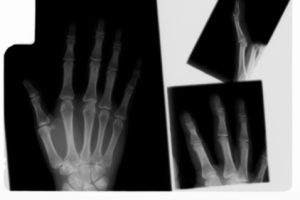 Hand pain has many causes, including injury and disease. Fortunately, many of those causes can be treated and the symptoms eased.
Hand pain has many causes, including injury and disease. Fortunately, many of those causes can be treated and the symptoms eased.
Here are some of the most common conditions that cause hand pain:
De Quervain's tendonitis.This is also known as de Quervain's tendonosis. It causes pain on the thumb side of the wrist.
The pain may develop gradually or suddenly. It can travel the length of the thumb and up the forearm. If you have de Quervain's tendonitis, movements that can be painful include:
- making a fist
- grasping or holding objects
- turning the wrist
The pain results from swelling of the wrist tendons at the base of the thumb, which is caused by irritation or inflammation. Repetitive activities and overuse are often responsible for the onset of de Quervain's.
New mothers are at high risk because of the awkward position in which they hold their baby and their fluctuating hormones. Wrist fractures can also increase your risk of de Quervain's. Pain relief treatments include:
- wearing a splint to rest the thumb and wrist
- anti-inflammatory medications
- cortisone injections
Surgery is an option if symptoms remain severe after other treatments have been tried.
Carpal tunnel syndrome. This is one of the most common nerve disorders. It affects about 4 million to 10 million Americans.
Carpal tunnel syndrome causes pain in the:
- palm and some fingers of the hand
- wrist
- forearm
Often the pain is worse at night than during the day. Carpal tunnel syndrome can also causes:
- weakness
- tingling
- numbness
These symptoms can be particularly noticed in the thumb, index finger, and middle finger. This can make it hard to grip objects.
The discomfort occurs when swelling presses against the median nerve. The median nerve controls sensation and muscle impulses in the thumb and fingers (except for the pinkie finger).
The median nerve passes through the carpal tunnel. The carpal tunnel is a structure made up of bones and connective tissues that is located at the base of the hand. It is in this narrow space that the median nerve is pinched by inflamed or irritated tendons or other swelling.
Common treatments include:
- resting the hand and wrist
- anti-inflammatory or analgesic painkillers
- wrist splints steroid injection physical therapy
Surgery may be suggested if symptoms persist for six months or more.
Fractures. A fracture, or a break in a bone, can cause a great deal of hand pain. Besides pain, after a fracture you may have:
- stiffness
- swelling
- loss of movement
If you have fractured a finger, for example, you may be unable to move it fully. You might also notice that the injured finger is swollen and in some cases slightly shorter than normal.
There are several types of fractures:
- simple
- complex
- comminuted
- compound
SOURCE: WebMD www.webmd.com



